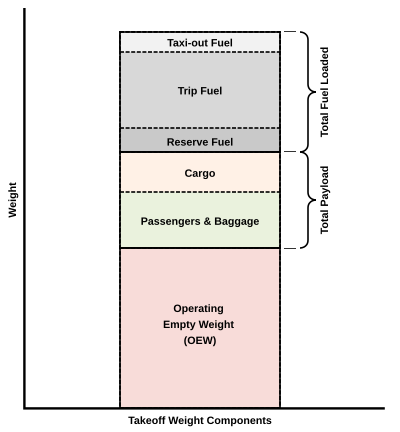The maximum takeoff weight (MTOW) or maximum gross takeoff weight (MGTOW) or maximum takeoff mass (MTOM) of an aircraft is the maximum weight at which the pilot is allowed to attempt to take off, due to structural or other limits. The analogous term for rockets is gross lift-off mass, or GLOW. MTOW is usually specified in units of kilograms or pounds.

MTOW is the heaviest weight at which the aircraft has been shown to meet all the airworthiness requirements applicable to it. MTOW of an aircraft is fixed and does not vary with altitude, air temperature, or the length of the runway to be used for takeoff or landing.
Maximum permissible takeoff weight or "regulated takeoff weight", varies according to flap setting, altitude, air temperature, length of runway and other factors. It is different from one takeoff to the next, but can never be higher than the MTOW.
Certification standards applicable to the airworthiness of an aircraft contain many requirements. Some of these requirements can only be met by specifying a maximum weight for the aircraft, and demonstrating that the aircraft can meet the requirement at all weights up to, and including, the specified maximum. This limit is typically driven by structural requirements – to ensure the aircraft structure is capable of withstanding all the loads likely to be imposed on it during the takeoff,[1] and occasionally by the maximum flight weight.[2]
It is possible to have an aircraft certified with a reduced MTOW, lower than the structural maximum, to take advantage of lower MTOW-based fees, such as insurance premiums, landing fees and air traffic control fees are MTOW based.[3][4] This is considered a permanent modification.[3]
Alternatively, holders of an Air Operator Certificate (AOC) may vary the Maximum Declared Take-Off Weight (MDTOW) for their aircraft. They can subscribe to a scheme, and then vary the weight for each aircraft without further charge.[5][3]
An aircraft can have its MTOW increased by reinforcement due to additional or stronger materials. For example, the Airbus A330 242 tonnes MTOW variant / A330neo uses Scandium–aluminium (scalmalloy) to avoid an empty weight increase.[6][7][8]
In many circumstances an aircraft may not be permitted to take off at its MTOW. In these circumstances the maximum weight permitted for takeoff will be determined taking account of the following:
The maximum weight at which a takeoff may be attempted, taking into account the above factors, is called the maximum permissible takeoff weight, maximum allowed takeoff weight or regulated takeoff weight.